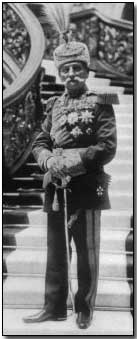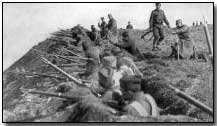Feature Articles - The Minor Powers During World War One - Serbia
 One of
the original protagonists of the war, Serbia had become the focus of Slav
national feeling within the Austro-Hungarian Empire. After the assassination
of Archduke
Franz-Ferdinand in Sarajevo, Austria
blamed Serbia for inciting
violence and declared war.
One of
the original protagonists of the war, Serbia had become the focus of Slav
national feeling within the Austro-Hungarian Empire. After the assassination
of Archduke
Franz-Ferdinand in Sarajevo, Austria
blamed Serbia for inciting
violence and declared war.
The initial Austro-Hungarian attack, on the 12th August 1914, took the town of Sabac. Civilians were rounded up and massacred before the Serbian army drove the Austrians back across their border on the 19th. It was the first Allied victory of the war.
At the start of 1915, Typhus ravaged the Serbian Front, severely weakening the Serb army. On the 5th October, the Austrians launched a major offensive against Serbia. The army, weakened by Typhus, couldn't hold out and Belgrade, the capital, was evacuated on the 9th.
Two days later, Bulgaria declared war on Serbia, hoping to annex the Serb possession of Macedonia. By the 24th, the Bulgarians had driven a wedge between the Serb army and the Allied armies in Greece attempting to come to their aid.
The Serbian army fought tenaciously, but was perilously low on ammunition. Eventually, over 200,000 soldiers and civilians fled over the mountains into Albania, and were evacuated by sea to Corfu in the largest sea evacuation until Dunkirk.
20,000 died in the mountains and more would be killed by air raids as they waited on the docks. The sick and wounded were transferred to the island of Vido (just off Corfu) which became known as the "Island of Death".
 Serb
soldiers made their way to Greece to serve in the Yugoslav Division of
Serbs, Croats, Macedonians, Montenegrins and Slovenes.
Serb
soldiers made their way to Greece to serve in the Yugoslav Division of
Serbs, Croats, Macedonians, Montenegrins and Slovenes.
The existence of this formation shows the determination of the Slavs to unite after the war. When, on 30th September 1918, Bulgaria surrendered, the way was paved for Serb, Yugoslav, French and British forces to drive the Austrian and German forces out of Serbia.
The Austrian 9th Division, composed mostly of Bohemians and Moravians showed its Slavic sympathies and ceased to be an effective fighting formation. On the 10th October, Serbian forces liberated Nis, having advanced 170 miles in 25 days.
Serbia's military casualties, at 125,000, are far lower than her civilian casualties. 650,000 Serb civilians died during the First World War. 65% of her military casualties were due to sickness and disease rather than enemy action. (Source: Stephen Pope & Elizabeth-Anne Wheal, 1995).
A 'Tracer' was a phosphorescent machine-gun bullet which glowed in flight, indicating course as an aid to artillery.
- Did you know?
